TRAVEL TWISTS
BY JEM LLANES MABALOT
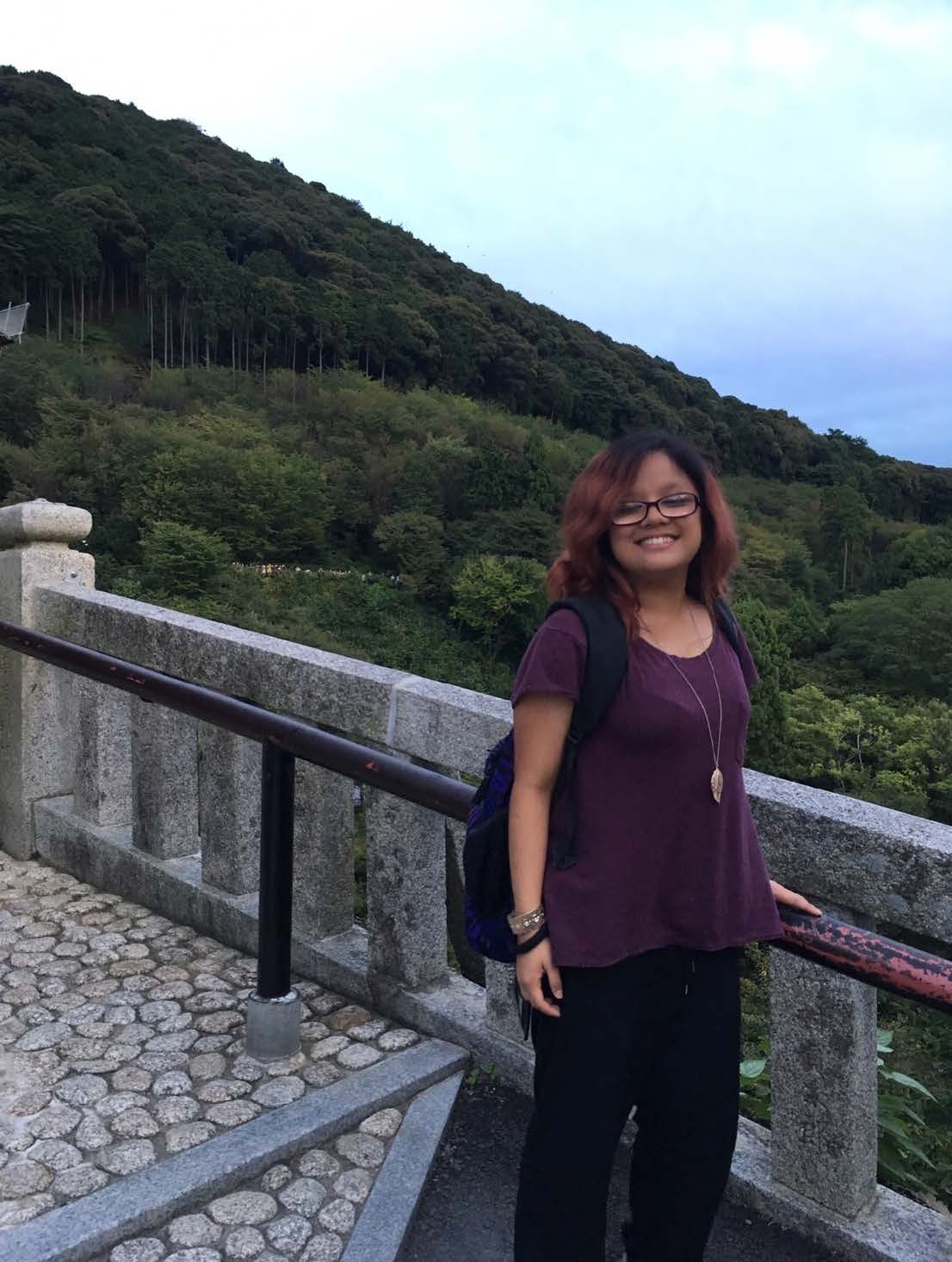
If you're a person with special needs like I am and would like to chase your dream, I urge you to challenge your limitations. Face them head-on and focus on your strengths rather than your weaknesses. Only then will you find the door to a much bigger, more colorful world full of wacky events and rich with learning.
I have low vision, but I set my sights on travel. My dream is to experience the diverse cultures of the world. So, when I was in my junior year of college, I grabbed the opportunity to study abroad in Japan, one of my favorite countries. From day one of my study abroad, I faced not only language and cultural barriers, but also visual disability challenges. I was thrown into a multitude of situations, some scary, others humiliating, but mostly hilarious.

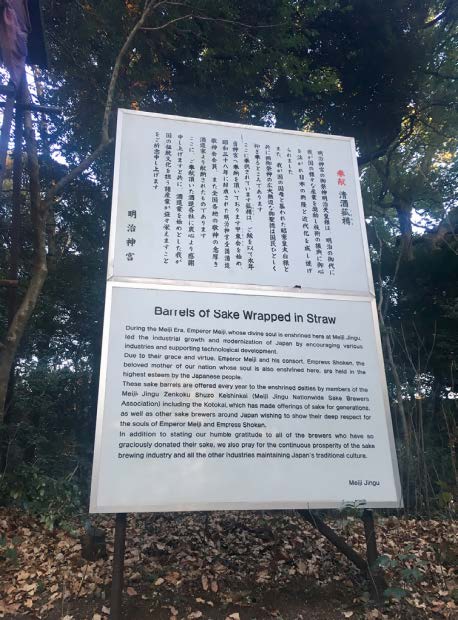

THE JOURNEY BEGINS: (Opposite page) The author visits Kyoto; (Above, left to right) Osaka Castle is certainly one of the most famous landmarks in Japan with a history that dates back almost 450 years; The Meiji Jingu Shrine features a huge collection of sake barrels, which the sign illuminates; (Inset) and the bewildering public transport map of Tokyo, the largest metro in the world serving 38 million people.
THE BUS
The hardest thing for me to learn in Japan was how to travel independently. I was forced to rely on friends to get around. For me, the bus system was difficult to get used to. The schedules are wacky. They're different on weekdays, weekends, and holidays, which are abundant in Japan. The bus numbers were tiny as ants, and there were no announcements that tell which bus is coming. Furthermore, the buses aren't always on schedule. On the bright side, onboard, there were automated announcements for every stop, a minute before arrival.
One evening, I rode the wrong bus getting home from school. I somehow ended up getting off in the middle of nowhere. It didn't look like the suburbs that I knew, but a rice field area with zero lighting. Initially, I thought I was alone, until some funky animals greeted me with hungry noises. Luckily, I had enough charge and data for Google maps on my phone.
I treaded across an open field using my phone as my flashlight and guide. I felt like the star of Man vs Wild, except the wild won a hundred to zero. I wished I had paid attention to my O&M (orientation and mobility) trainer in high school, instead of challenging my blind friend to a cane sword duel during our rural training. Boy, would that have been useful. After two long hours of walking, I finally found myself back in civilization. Actually, two police officers found me. They led me in the right direction and away from a dangerous construction site. Woo! My exciting adventure was finally over, and I was still alive. From then on, I became cautious about taking the bus. I planned to go to my stop early and opted not to ride a bus if I wasn't confident where it would go. More important, I always remembered to bring extra portable chargers for my pocket Wi-Fi and phone in case I got caught up in another Indiana Jones mini adventure.
THE TRAIN
Catching the right bus was like playing THE JOURNEY BEGINS: (Opposite page) The author visits Kyoto; (Above, left to right) Osaka Castle is certainly one of the most famous landmarks in Japan with a history that dates back almost 450 years; The Meiji Jingu Shrine features a huge collection of sake barrels, which the sign illuminates; (Inset) and the bewildering public transport map of Tokyo, the largest metro in the world serving 38 million people. darts, but navigating around by train was akin to finding a way out of a labyrinth. I noticed that even some sighted people, both foreigners and locals, found the rail system confusing. Thing is, you need to identify your route and buy the ticket for it. But, the different routes on maps, coded with all colors imaginable, were muddled into one another like a rainbow of chaos. "Did they really want to sell tickets?" I wondered.
I felt doomed! Desperate to gain independence, I scoured around for a solution. Eventually, I discovered that majority of locals don't buy tickets, they use prepaid IC (integrated circuits) cards to pay for public transport fares. I immediately joined the bandwagon and got an ICOCA, Western Japan's brand of IC card.
Sayonara to frustrating ticket purchases and confusing maps! Fortunately for me, Japan's rail system turned out to be accessible for the visually impaired. Trains are distinguishable by line and always arrive precisely on schedule. The structure saved me the horror of hopping on the wrong train, as long as I was on the right platform. A lifesaver, Google Maps told me which train to take, in which platform, at what time, down to the last minute. Announcements in Japanese and English informed passengers which train was arriving on the platform, and which stop the train would arrive at when onboard. All I needed was my ICOCA, Google Maps, and lots of courage. One day, I conducted an experiment. I blindly hopped on a couple trains and got off on random stops. Voila, I found my way back home! Of course, I rewarded myself with takoyaki (baked octopus ball). Since then, I was able to go anywhere I wanted and explore places alone.
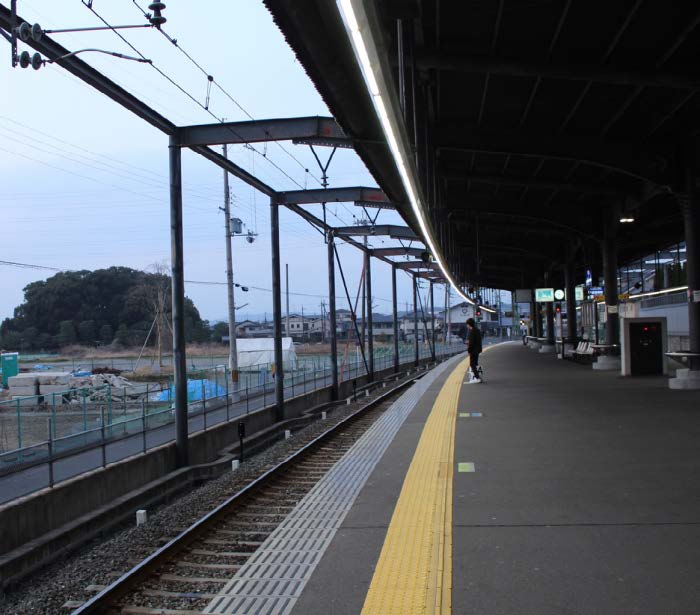
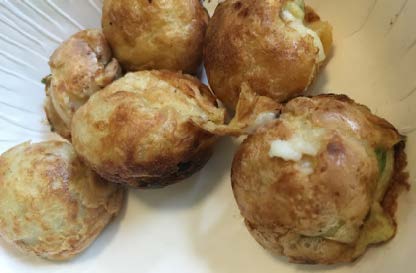

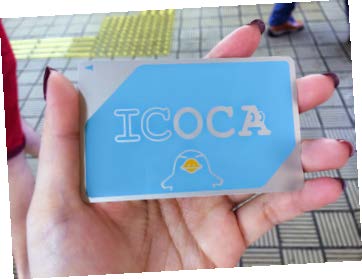
GETTING THERE: (Above, left to right) The metro system can be daunting at first, but with a prepaid ICOCA card and Google maps, traveling around the city is viable for even those with disabilities; Takoyaki, or octopus balls are a delicious reward for learning how to navigate the train system; (Inset) The ICOCA has an integrated circuit that tracks usage at the stations.
A TRIP TO THE DRUG STORE
Usually, Japanese characters have too many strokes clumped together, and I would just see the blurry blocks and lines on signs from afar. So, I would take photos of signs and labels to zoom in and be able to read them up close. This became my modus operandi to get by daily. Locals are used to seeing tourists taking shots and admiring their photos of attractions like Fushimi Inari, Osaka Castle, or of Instagram-worthy meals. I, on the other hand, was the weirdo that took random pictures of products in stores. I wondered what people thought when they saw me happily staring at a photo of two-for-50 percent-off beef on my iPhone 6s plus, as if I'd discovered a new attraction. Hey, it was a good deal!
At a drug store, I discretely took pictures of different products in GETTING THERE: (Above, left to right) The metro system can be daunting at first, but with a prepaid ICOCA card and Google maps, traveling around the city is viable for even those with disabilities; Takoyaki, or octopus balls are a delicious reward for learning how to navigate the train system; (Inset) The ICOCA has an integrated circuit that tracks usage at the stations. search of aromatic bath salts. A store clerk noticed my struggle and approached me to help out. I hadn't found a picture of the product, and I didn't know how to say "bath salts". Distressed, I quickly looked up the translation on my phone. As luck would have it, the dictionary didn't have an accurate translation. I did my best to explain what I wanted in my limited Japanese, but to no avail. So, the store clerk and I started playing numerous rounds of awkward charades. "Bath salts," I repeated in both English and Japanese pronunciations. The clerk watched closely as I theatrically enacted myself using bath salts in the tub. I felt like we were performing a Dumb and Dumber skit. Forget about saving face. I was past the point of embarrassment and was determined to get a good soak that night. Finally, I showed him a picture of bath salts.
His face lit up and eagerly shouted, "Ah benpi." I didn't know what the word meant at the time. But, pretentious, I played along and enthusiastically said, "Yes, yes!" I was hoping to get a box of bath salts. Low and behold, he proudly surprised me with a box of constipation medicine. I was mortified. In a desperate attempt to end my torture, he frantically called the manager. Now, we were Dumb, Dumber, and Dumbest. Miraculously, after a good while, the manager pieced the puzzle together. Finally, I got what I wanted! Never did I forget the words for "constipation" and "bath salts" in Japanese ever since.
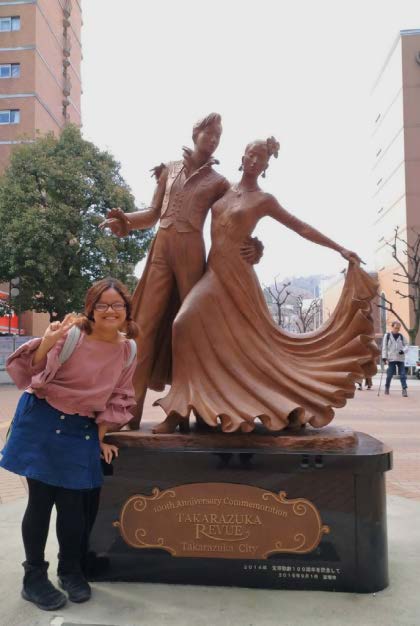
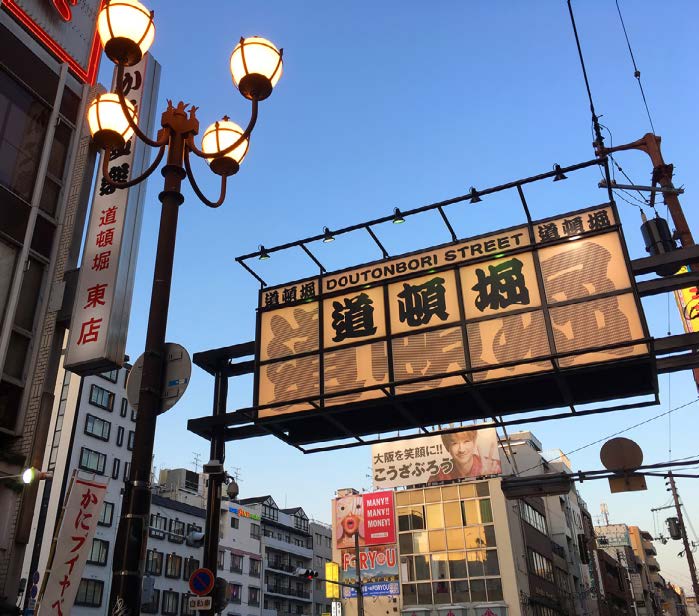
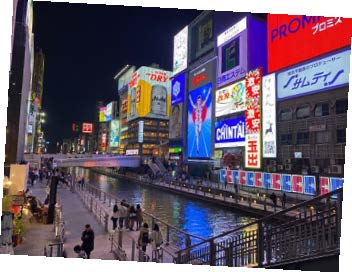
TAKING IT IN: (Above, left to right) Takarazuka is a city is known for its hot springs and its allfemale Takarazuka Revue, both of which are now the main draw for visitors; The lively Doutonbori area is renowned for its gaudy neon lights, extravagant signage, and the enormous variety of restaurants and bars. (Inset) Doutonbori at night.
MY FIRST DAY OF INTERNSHIP
I rely on Google Maps to go places, but, sometimes, it throws me off and into a mystery adventure. On normal days, I would have enjoyed the detour. But not on my first day of internship! My internship was at a school, in a town close to where I lived. I visited the school only once, and I vaguely recalled the way there. As always, I typed the address onto Google. Initially, the route looked familiar, and I passed the 7-Eleven I designated as a landmark. I was on the phone with my worried mother, but I assured her I could find my way around the area. Soon, I saw the front gates of a school building with familiar characters written on the sign. I felt relieved to arrive early, unusually early.
I entered the school. A tall and handsome teacher welcomed me. I felt excited to work with a good-looking young man. He volunteered to help me locate my shoe locker while I tried to flirt with him. My advances were cut short when we couldn't find my locker. I followed the man to the teachers' room, my shoes on hand. The man asked the other teachers for my desk space, name tag, and schedule.
Shortly after the teachers started searching, I suddenly heard them panicking, yelling out in Japanese exclamations and saying, "Eh, what do you mean?" The handsome man explained the situation to the principal. "This is Katano School. Your school is Katanoshi School," she informed me, cackling.
After that, I didn't know which was louder, my mother's hysterical laughter piercing through my earphone, or the principal's howling that reverberated in the room. I couldn't believe I went to the wrong place! Fortunately, the principal was kind enough to take me to the right school. The rest of the day went well, except for my disappointment that I didn't get to work with the handsome teacher. So much for abiding by the Japanese code to not trouble others. I was reminded that day to always be cognizant of my surroundings and to double-check the route for my destination.
MY INTERNATIONAL FLIGHT EXPERIENCE
Before flying abroad, my mother advised TAKING IT IN: (Above, left to right) Takarazuka is a city is known for its hot springs and its allfemale Takarazuka Revue, both of which are now the main draw for visitors; The lively Doutonbori area is renowned for its gaudy neon lights, extravagant signage, and the enormous variety of restaurants and bars. (Inset) Doutonbori at night. me to acquire wheelchair service because the airlines didn't provide sighted guides. It seemed like a good idea at the time. I wanted a smooth, predictable, on schedule flight to Osaka. I was fine being wheeled away to my plane in New York. When I asked to walk alongside the airport staff, they let me. When I wanted to sit back down, I could. The JFK staff even offered to take me to my desired meal stop and shops. Onboard my domestic connection flight, I was well taken care of, and they let me sit on my favorite spot, the window seat, in an empty row. But as soon as I left New York, my situation became disastrous.
pal. "This is Katano School. Your school is Katanoshi School," she informed My flight to China, the next stopover, was terrible. They gave me a window seat, beside two annoying old men who were bantering with each other in Chinese. Passengers were prohibited from opening the window shades or using their phones, even on airplane mode during the flight. I was stuck for 14 hours, irked by the two men yapping away, gazing at the closed window shade, or staring blankly at my tiny PTV (personal TV), which I couldn't see nor use. My only relief was the bathroom, mealtime, and sleep, of which I didn't get much.
Exhausted from the flight, I wanted to walk to stretch my legs, but they didn't let me off the wheelchair. Grrrr! I was livid. Placing my hands on my hips, I felt a medicine bottle in my jacket pocket. My anger instantly turned to fear. It was Tylenol. My mom slipped it in for my chronic headaches, which I often get on planes. Japan didn't allow a certain dosage of Tylenol in their borders. I knew the bottle had to go before leaving the airport. But I also didn't know the restrictions in China, and I was terrified.
and I was terrified. "Can I go to the restroom?" I asked the wheelchair lady, hoping to ditch the bottle. She responded in broken English, "Sorry, wait please. Bathroom after check." Scenarios of me being questioned by the Chinese government flashed in my imagi nation. Luckily, I saw a trashcan on the way. "This is my only chance," I thought.
"If this doesn't shoot, I'm dead." I wrapped the bottle with a used tissue inside my pocket and nonchalantly threw it. I never found out if the bottle went in or not, but the lady continued to wheel me to check-in. The Tylenol was gone, but my anxiety wasn't. Needing to vent, I tried opening Facebook to post my experience after check-in. Facebook wouldn't load. The great firewall of China blocked the app. The good news is, I made it to Japan safely, but I swore to myself that I would never take the same airline and stopover.
My trip back home was more bearable than my trip to Japan. I didn't have to use a wheelchair because Kansai airport provided sighted guides. The flight to America was peaceful.
FINAL THOUGHTS
As I look back on this part of my life, I feel a sense of accomplishment from overcoming barriers, even though, at that time, some of my experiences were unsettling. I learned to be stronger and independent by stepping out of my comfort zone. I don't regret a single moment, and I would gladly snatch the chance to go through more lifechanging travels to broaden my view of the world.
If you're a person with special needs like I am and would like to chase your dream, I urge you to challenge your limitations. Face them head-on and focus on your strengths rather than your weaknesses. Only then will you find the door to a much bigger, more colorful world full of wacky events and rich with learning. •
ABOUT THE AUTHOR:

Jem Mabalot, born with aniridia and legally blind, is a fresh graduate of the College of Charleston with a B.A. in International Studies. Her passion is teaching the youth and learning languages such as Japanese, Korean, and Chinese. She loves exploring different cultures and wants to be a media influencer to inspire and lead the youth from different backgrounds and abilities to pursue their dream. Her calling is to establish a nonprofit organization for talent development and empowerment for children in Asia. Currently, she is teaching ESL online and working on her Certificate in Teaching English to Speakers of Other Languages (CELTA). She is planning to launch her YouTube channel soon.•